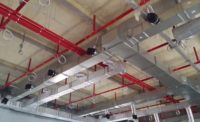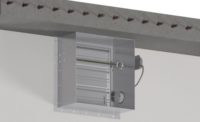With today’s continually advancing building engineering technology, design professionals are presented with a multitude of options for HVAC design. With such variety comes the burden of comprehending all of the design coordination and code compliance implications — in particular, when it comes to proper fire and smoke damper design. Many of the unique design elements in today’s building design require the mechanical engineer/designer to be familiar with many more options for proper code compliance of fire/smoke damper design and coordination than ever before.
There are many design parameters when it comes to understanding the full complexity of fire and smoke damper design and installation. This article will attempt to cover a few of these complexities. The information presented will assume the reader is already familiar with the basic concepts, terminology, and code requirements for fire/smoke damper design and installation. The goal is to present some design options that are atypical of common fire/smoke damper design, and also to provide the reader some of the damper design pitfalls to avoid or understand further. We’ll explore the following questions.
• What are the options available to a design of HVAC systems for providing a code-compliant fire and smoke damper installation?
• What are some of the common design issues and considerations to be aware of when producing fire/smoke damper design documents?
This article represents an overview of this particular subject matter and is by no means intended to cover all of the details required for full design coordination and/or code compliance.
Design Options
The following are a few unconventional alternatives that a designer may want to consider in future designs for fire and smoke damper placement.
Combination Fire, Smoke and Volume Control Dampers
One of the least-utilized available options for HVAC design is the combination fire/smoke volume control damper. In many instances, the mechanical system design utilizes two separate dampers to provide the two separate desired functions. Due to building HVAC requirements to provide on-demand heating and cooling, a volume control damper is a must. In addition, as these ducts penetrate rated/smokeproof walls, appropriate UL-listed fire and/or smoke dampers need to be present for code compliance. What if you could combine the two required installations into one to provide for a more flexible design and reduce project costs? Several of the larger damper manufacturers provide such a solution.
The right type of control/isolation damper selected can save on the project cost as well as reduce space requirements. The combination damper is performing the tasks traditionally done by two separate dampers. Combining these damper tasks also reduces the amount of equipment that requires access. The downside to this approach is that the combination damper controls become slightly more complex, as the fire and/or smoke control system must be set to override any other control signals that the damper actuator receives. Very detailed coordination is absolutely necessary with the controls engineer/designer to ensure all code-required life safety requirements for fail-safe procedures are accounted for.
Electrically Operated Fire Dampers
Another option, not often utilized but available to designers, is to specify non-fusible link-type fire dampers that are motorized and are operated by activation of an associated heat detector. This approach is similar to the standard operation of a smoke damper with an integral smoke detector. This is a viable option for where constraints to airflow exist due to the physical partial blockage created by a standard, fusible link fire damper (constant presence of the recessed damper blades). This is also a good option for tight ceiling configurations in the design where a recessed typical damper is not desirable. The fire dampers typically utilized for this option are the multiple blade type versus the standard single, roll down curtain-type fire dampers. The design and use of heat detector-initiated, motorized fire dampers is very common throughout Europe and their use is starting to become more prevalent in the United States.
To utilize this option, the engineer/designer should ensure the heat detector associated with the fire damper is tied into and monitored by the building fire alarm system similar to the connection of smoke detectors associated with smoke dampers. In addition, the designer should ensure the heat detector specified is compatible with the base building fire alarm system. Lastly, the designer should check with the local code authority to verify whether this approach is acceptable, as this option is not standard practice and the plans reviewer may not be familiar with the specific operation methodology of this type of fire damper.
Area Room Smoke Detectors to Initiate Smoke Dampers
With the standard smoke damper installation, a smoke detector (either spot or duct type) to initiate operation of the smoke damper closure is specified. There are instances where the mechanical design has locations for very small duct sizes, and depending on the standard sizes of dampers available from a particular manufacturer, it may not be possible to utilize a duct-type or spot-type detector for these small duct penetrations through a smoke partition or barrier. Concern with duct detectors with small duct penetrations is that duct detectors have a minimum required air velocity requirement for detection and activation. Smaller duct sizes equates to reduced air flow velocity. With spot-type detectors, the issue becomes one of physically installing the spot-type detector inside the smaller diameter duct and providing access. If designers find themselves in this particular situation, there is another option to consider. The use of area smoke detectors in the room with which the smoke damper is associated can be a great option.
The designer would coordinate with the electrical or fire alarm engineer to provide the code-required number of spot-type smoke detectors below the finished ceiling of the protected room. The activation of any one room’s smoke detector would automatically initiate the operation of the smoke damper, thus eliminating the requirement for any detector at the interface of the smoke damper and the smoke-resistive wall. Additional devices, such as fire alarm addressable relay modules, will be required for the tie-in between the building fire alarm system and the smoke damper-powered actuator.
Design Considerations
The following are some common design pitfalls to avoid and design items that require further understanding related to fire and smoke dampers. This list can serve as a checklist for an engineer or designer to review prior to issuance of construction documents.
1-Hour/Automatic Sprinkler Exception
The International Building Code (IBC), as well as many state and local jurisdictional amendments, have provisions to allow for less stringent fire and smoke damper code requirements relating to placement. One very common exception that seems to be overlooked periodically is the allowance to omit a fire damper in fully ducted penetrations of one-hour fire barrier walls or partitions in a fully sprinklered building. A listed smoke damper would still need to be provided in most cases. Designers, out of ingrained design habits or to provide a more conservative design, often place fire dampers in ducts in all instances where they penetrated rated walls. Being cognizant of such rules in the building codes can not only help save money in the design but also eliminate unwarranted maintenance and testing in the future.
In addition, many local jurisdictional amendments go even further than the model building codes in the reduction of damper requirements. For example, projects in the District of Columbia are allowed to also omit smoke dampers in ducts that penetrate shafts where the building is provided with an automatic sprinkler system. Depending on the project specifics (building height, building area, and number of mechanical shafts), these available reductions for fire and smoke damper placement can result in substantial savings on a project.
Dampers in Ducts Serving Smoke Control Systems
Another common designer oversight involves placing fire and/or smoke dampers in ducts that serve as part of a smoke control system. The IBC specifically prohibits installation of fire and smoke dampers in ducts serving engineered smoke control systems. This includes ducts serving atrium smoke exhaust makeup air or ducts serving stair pressurization systems. In these instances, it is important for the designer to make sure that fire and smoke dampers are not placed in ducts serving smoke control systems to ensure that proper operation and function of the smoke control system is not prohibited in the event of an emergency. The designer should coordinate with the project mechanical or life safety engineer responsible for the smoke control design(s) to identify all ducts that serve the smoke control systems. Note, the designer should also pay particular attention to all ducts upstream of the primary ducts serving smoke control systems and verify that fire and smoke dampers are also not placed in these accessory ducts.
Smoke Damper tie-in with the Building Fire Alarm System
There are two main options for specifying the smoke detector associated with smoke dampers in a project. Either the conventional smoke detector is specified to be purchased and installed integral with the associated smoke damper or the designer specifies an addressable smoke detector separately to ensure the detector is fully compatible with the base building fire alarm system. Regardless of the method specified, NFPA 72, National Fire Alarm and Signaling Code, requires all initiating devices to be monitored by the building fire alarm system. In most instances, the conventional smoke detectors that are integral with the smoke damper are non-addressable type. Where these types of detectors are applicable on a project, the mechanical designer should coordinate with the electrical or fire protection engineer to make sure a fire alarm addressable interface module is provided to monitor and give an address point to the non-addressable smoke detector.
The recommended and preferred design option a designer should follow to provide a less complex design and reduce a contractor’s in-the-field change orders is to have the electrical or fire protection engineer specify an addressable smoke detector separately from the smoke damper in the fire alarm drawings to guarantee full compatibility between the smoke damper and building fire alarm system, and then to have the mechanical engineer specify only the installation of the addressable smoke detector into the specific duct.
This approach not only simplifies coordination but also eliminates the issues with resetting a conventional, integral smoke damper smoke detector. With an addressable smoke detector, the system reset can be accomplished at the fire alarm control panel versus at actual smoke detector locations where, in many cases, the detector is located high at the ceiling or in difficult-to-access spots. In addition, addressable smoke detectors specified separately (versus integral smoke detectors) allow the ability to assign sensitivity settings. Depending on the type of environment or room where the smoke damper is located, it is a very important feature to have the ability to set the sensitivity setting on the associated smoke detector to minimize false alarms that are so prevalent with detection devices serving ducted systems.
Fire and Smoke Damper Access
Once the mechanical designer has completed all of the complicated coordination with fire and smoke dampers and has verified all code requirements are met, a critical last step in the design process is sometimes overlooked, one that is as critical as the design itself. This last step is confirming that the appropriate access panels at the ceilings and/or walls are provided and specified by the project architect to serve the fire and/or smoke dampers.
It is not only a code requirement but also a future building operations/functionality necessity for the panels to be provided for accessing the individual fire and smoke dampers for required maintenance, testing, and inspection. It is the obligation of the mechanical designer responsible for fire and damper placement to coordinate with the project architect to identify locations of such dampers and possibly identifying panel size requirements based on damper configuration.
The coordination is also important because depending on the building geometry and architectural wall/ceiling design, it may not be possible for the project architect to provide an access panel where the mechanical engineer desires. This can happen where a highly ornamental/aesthetic wall or ceiling design is provided and the architecture design intent was to have as minimal number of penetrations as possible, or where a particular wall or ceiling finish material (decorative metal or wood) is specified. Not coordinating the damper access panel locations could lead to the mechanical designer changing the routing of his or her particular duct layout to another location in the building.
Conclusion
This article hopefully provides the reader a deeper appreciation for all the complexities associated with, and the multi-discipline coordination required with, just one isolated aspect of HVAC design such as fire and smoke damper placement. As technology in building systems further progresses and as model building codes and standards continue to strive to keep up with the code changes and cyclical updates and amendments, it will become even more challenging for HVAC designers to stay ahead or even simply keep up with all of the product advancements. Regardless of the changes in the evolving mechanical design industry, engineers and designers need to consider, evaluate, and implement the most appropriate fire and smoke damper options for the specific building application to ensure the HVAC drawings and specifications reflect the most coordinated, efficient, and highest-value engineered system design.




